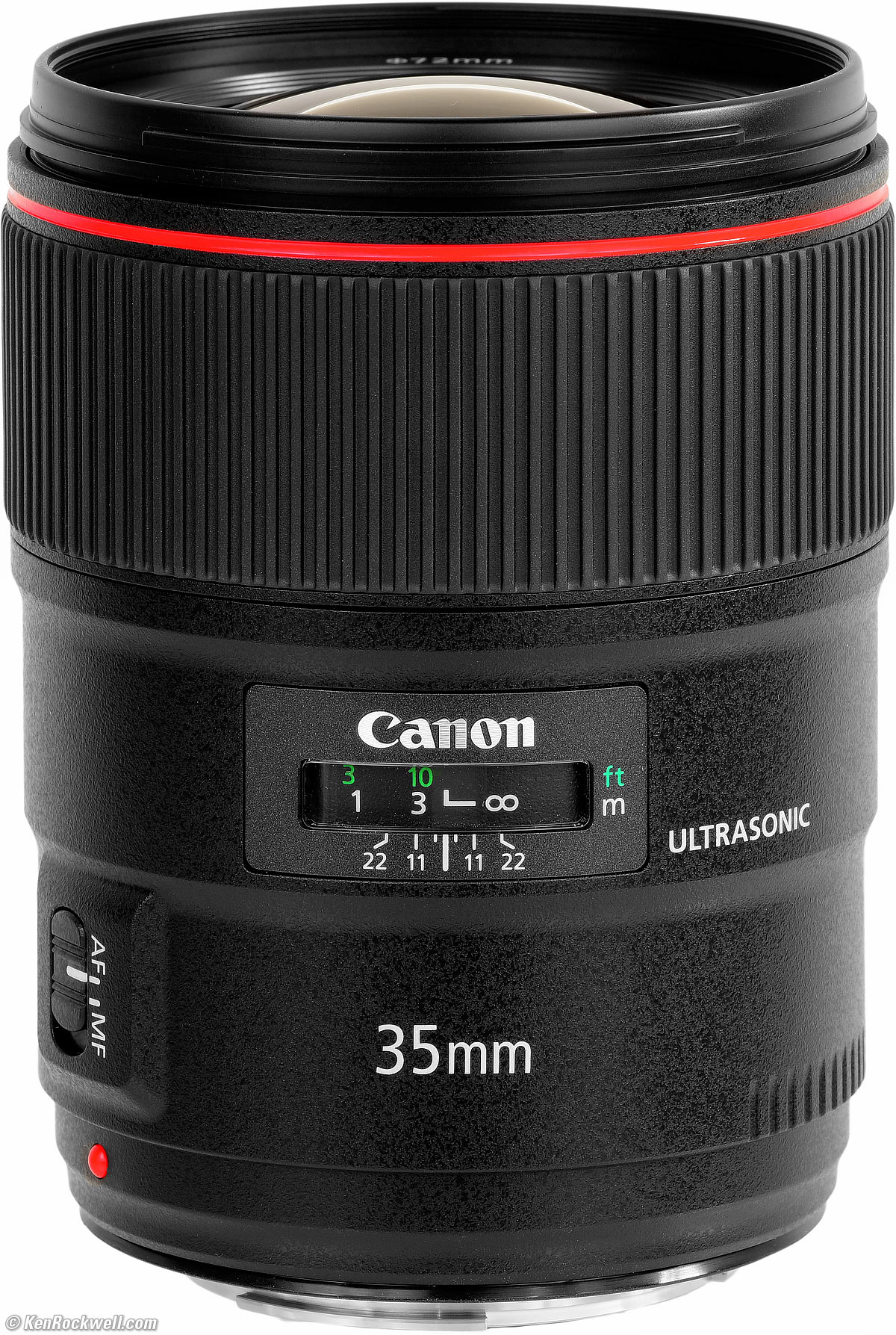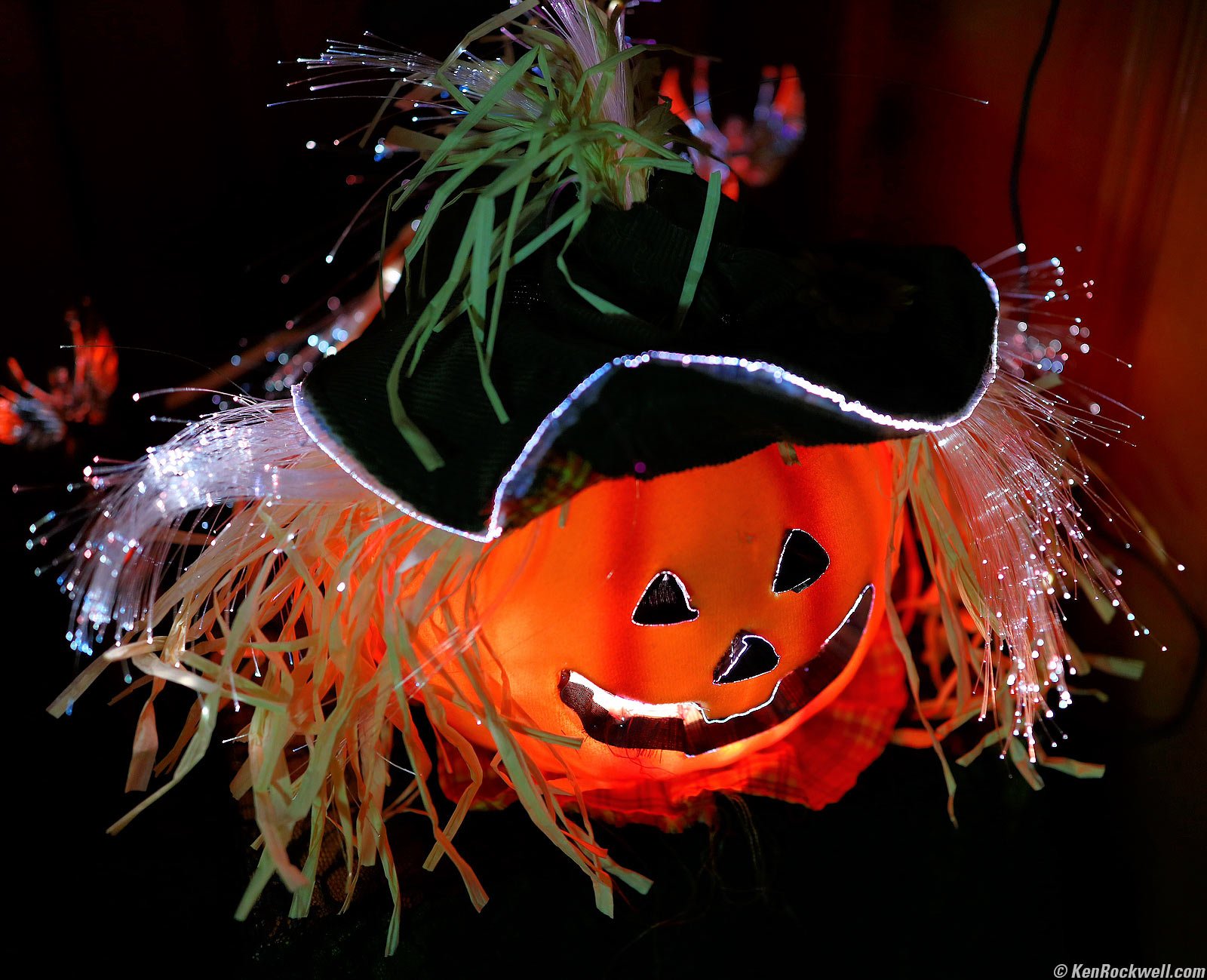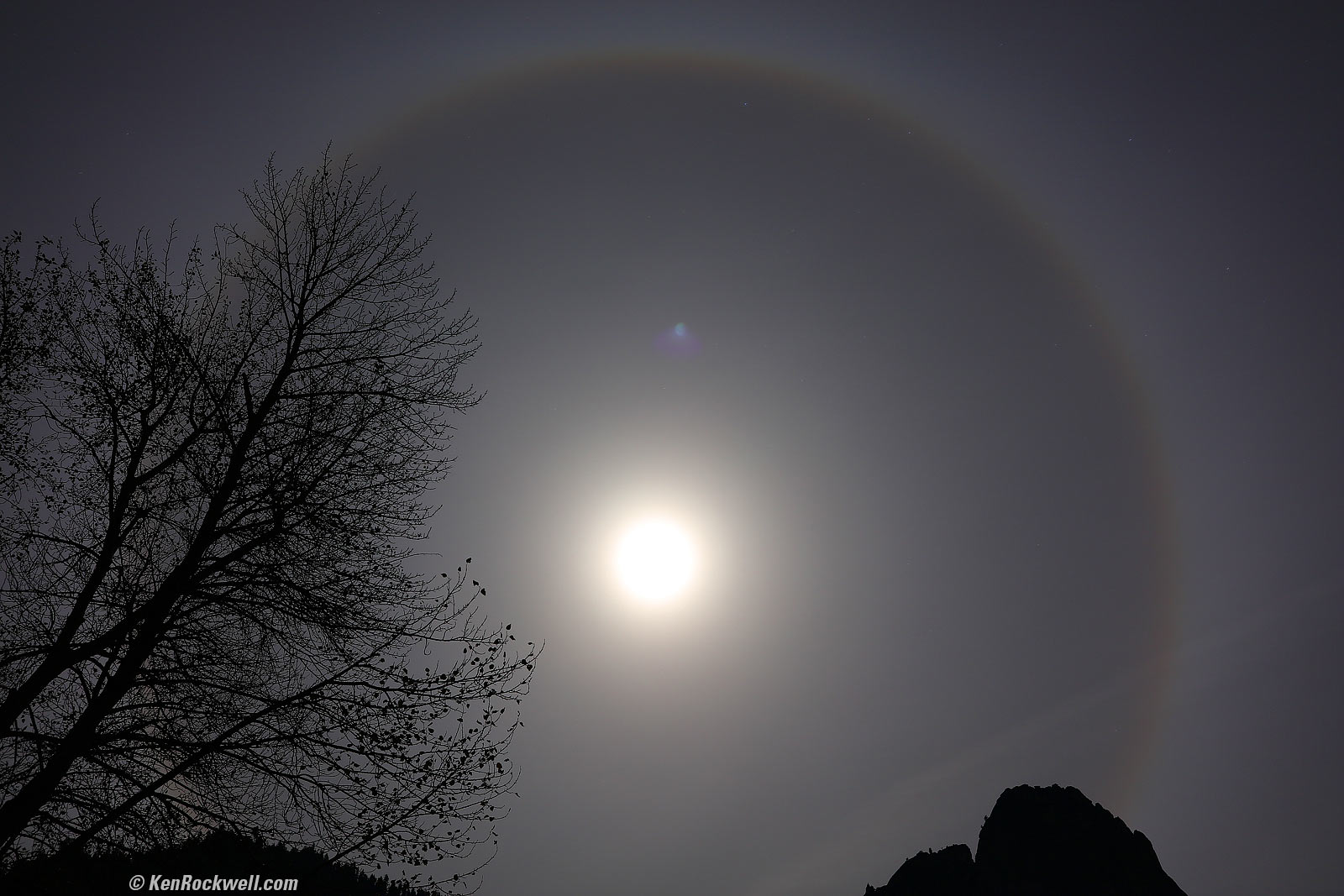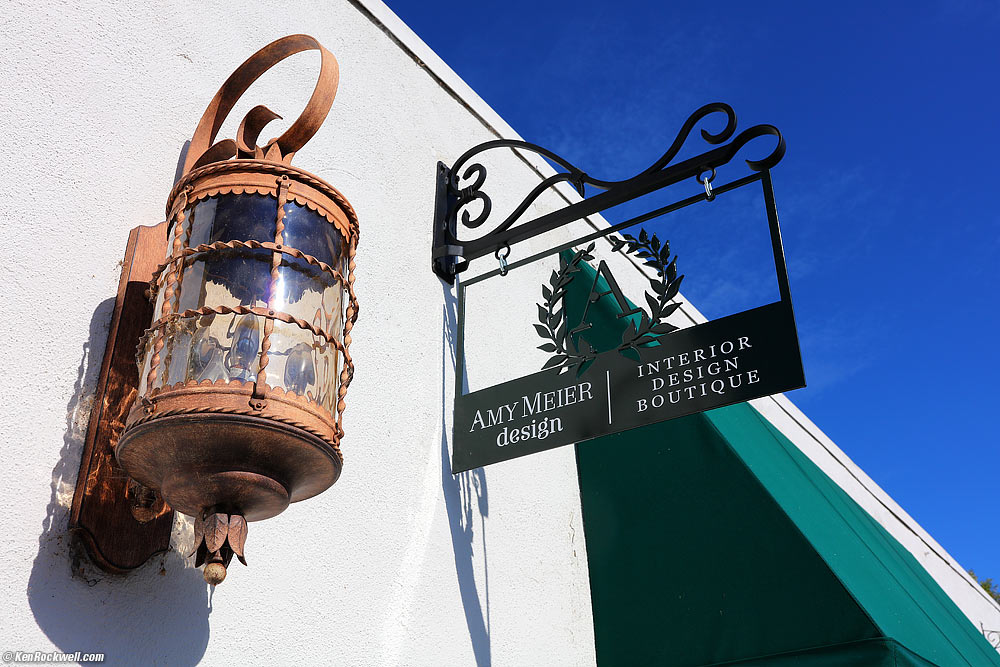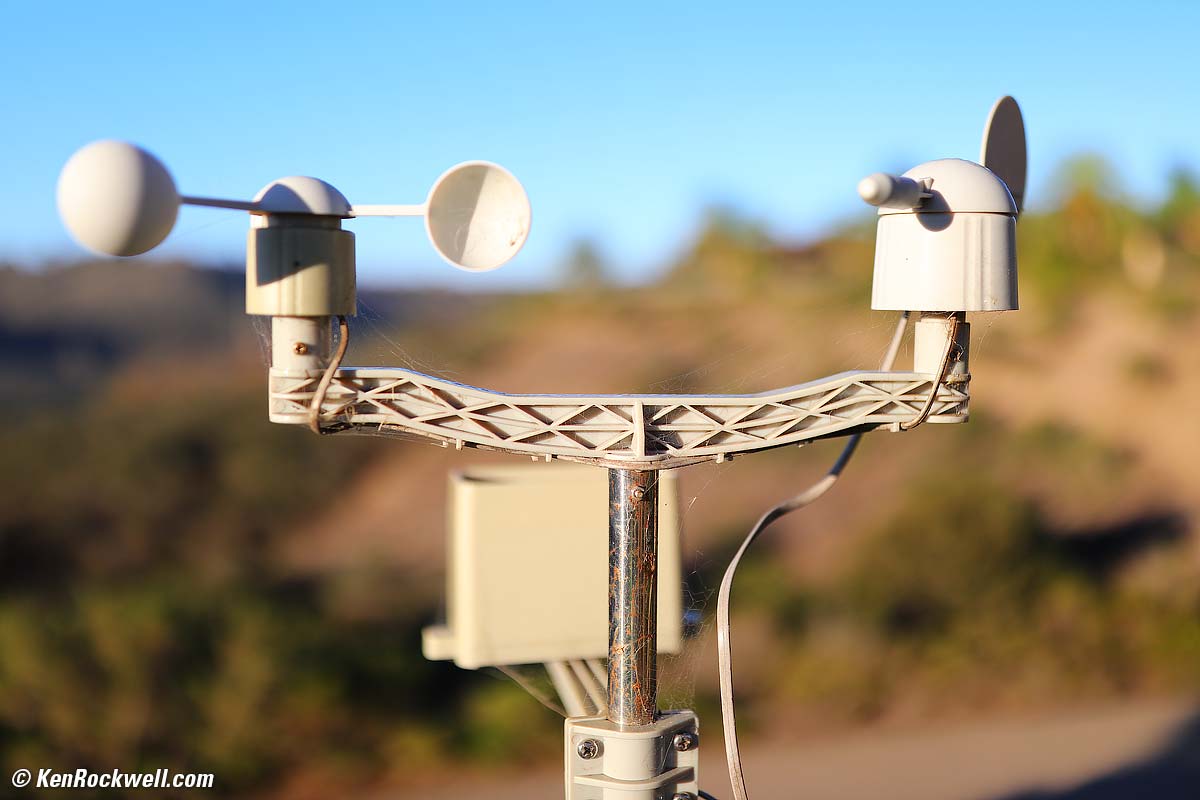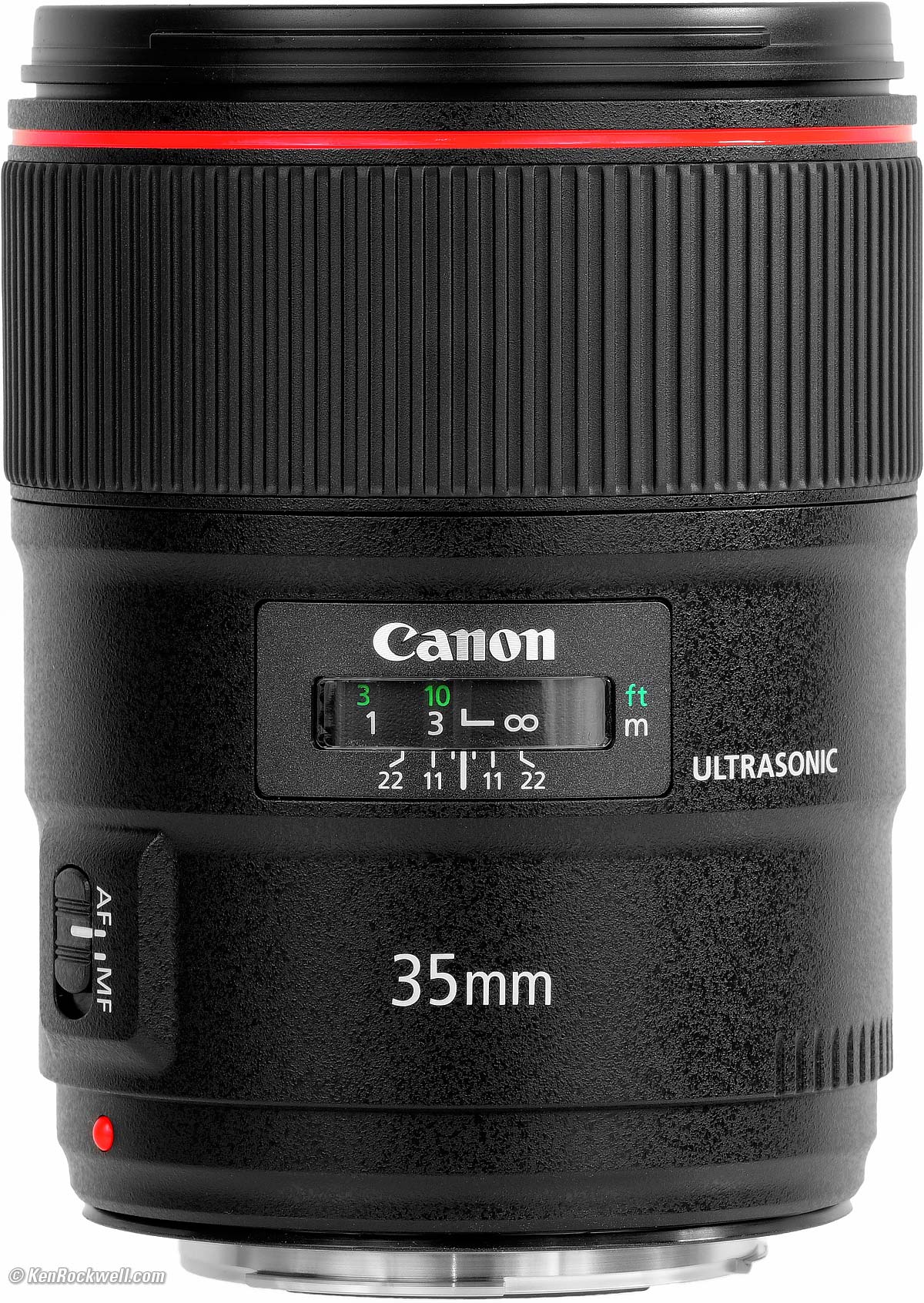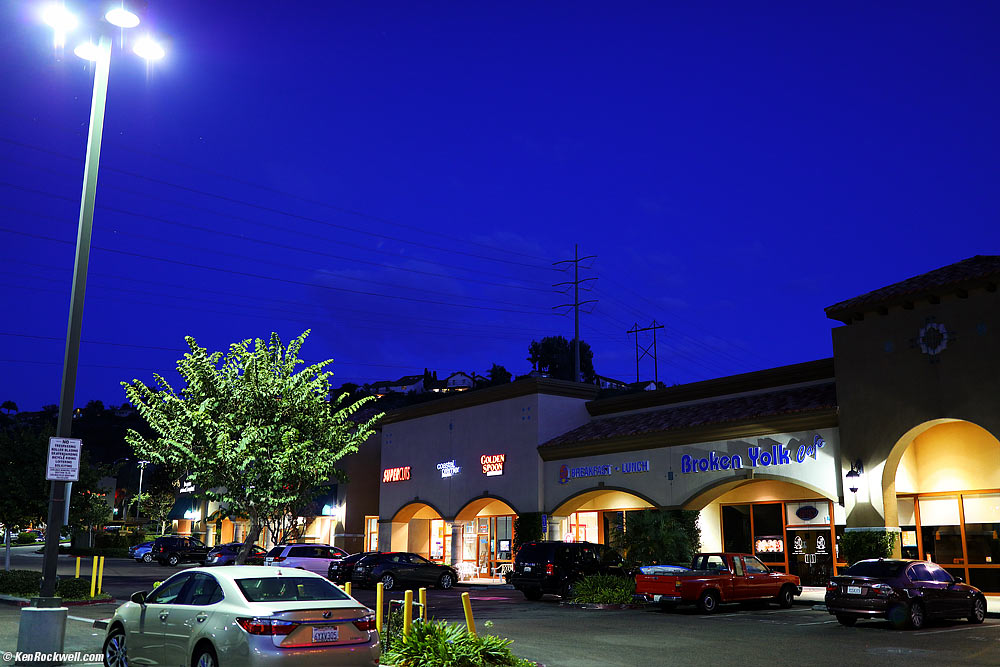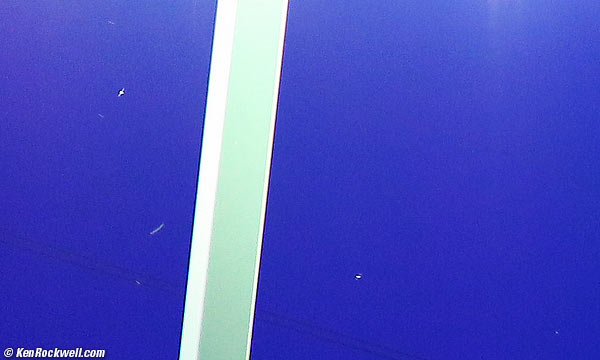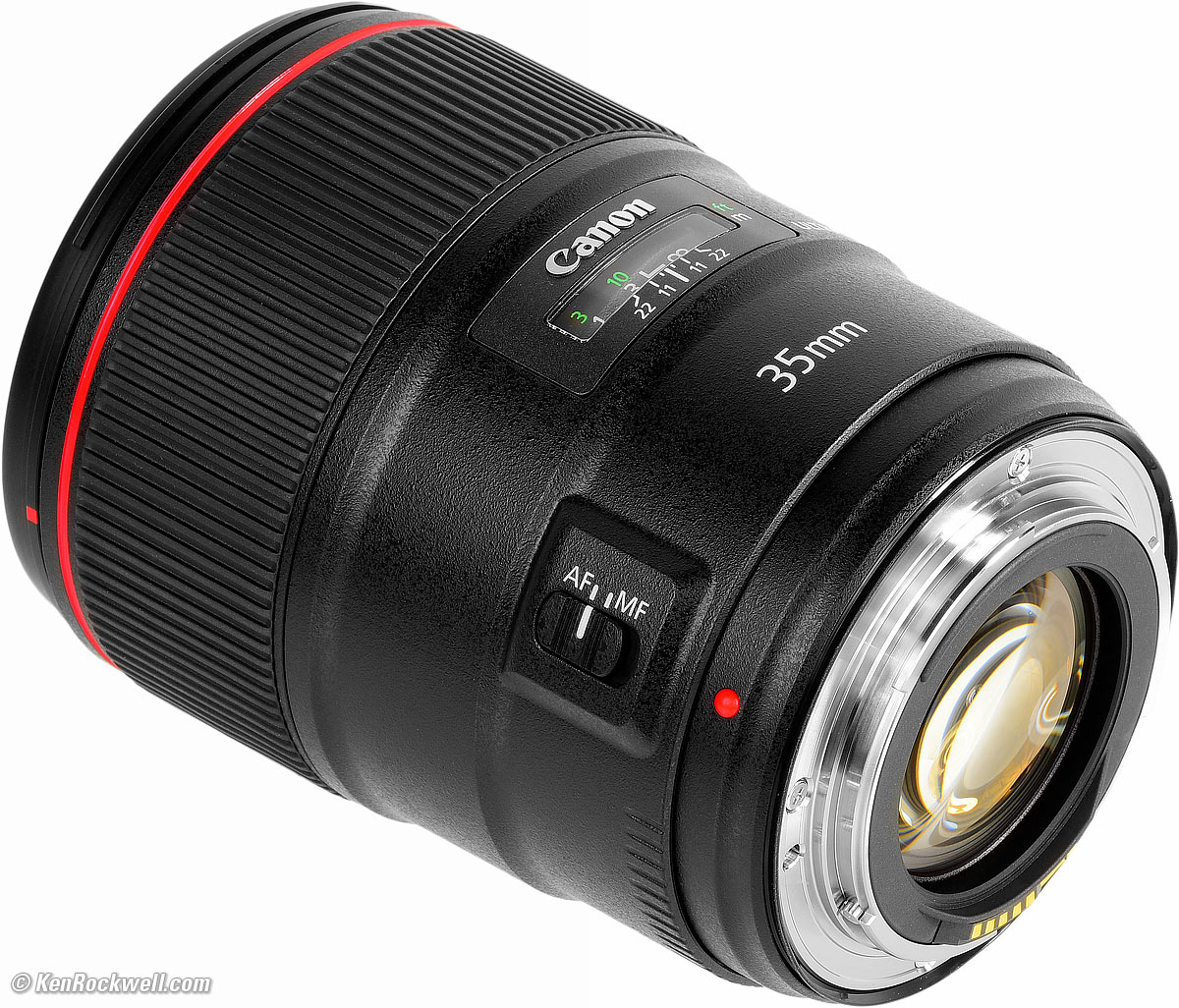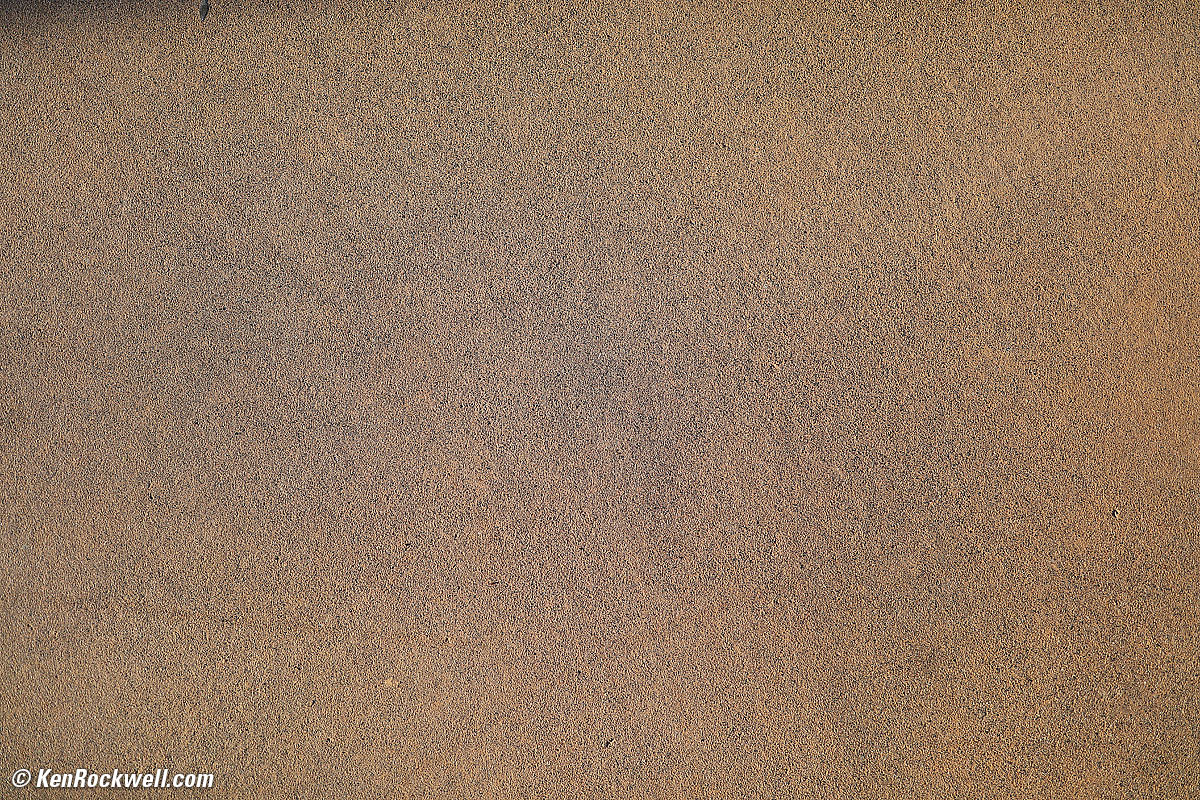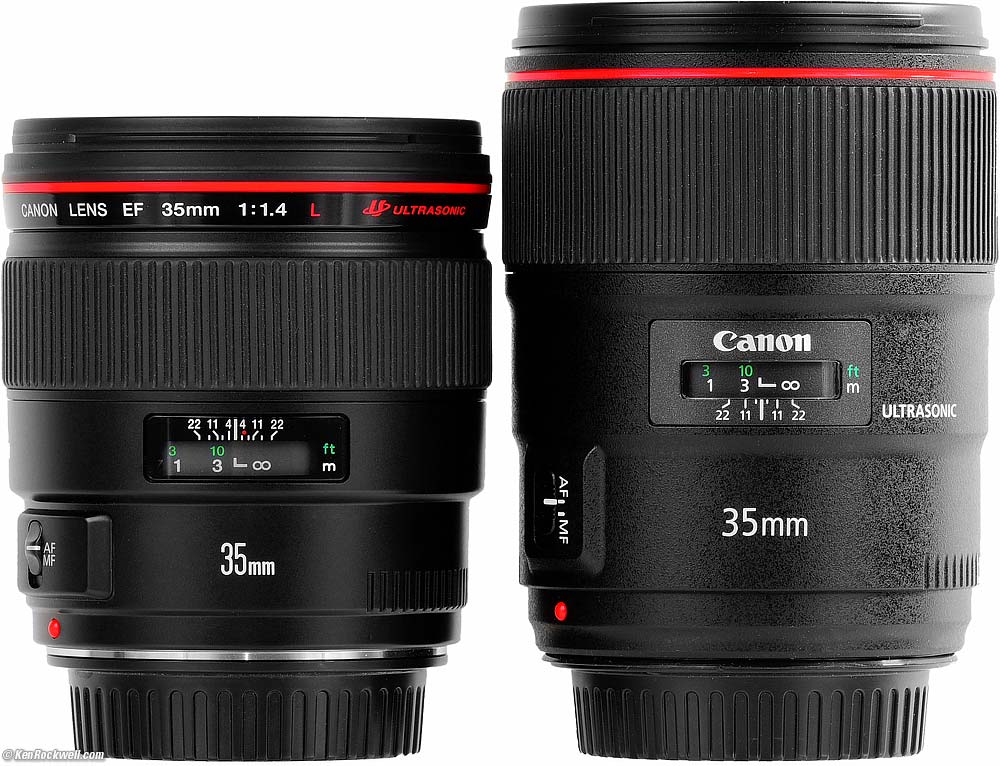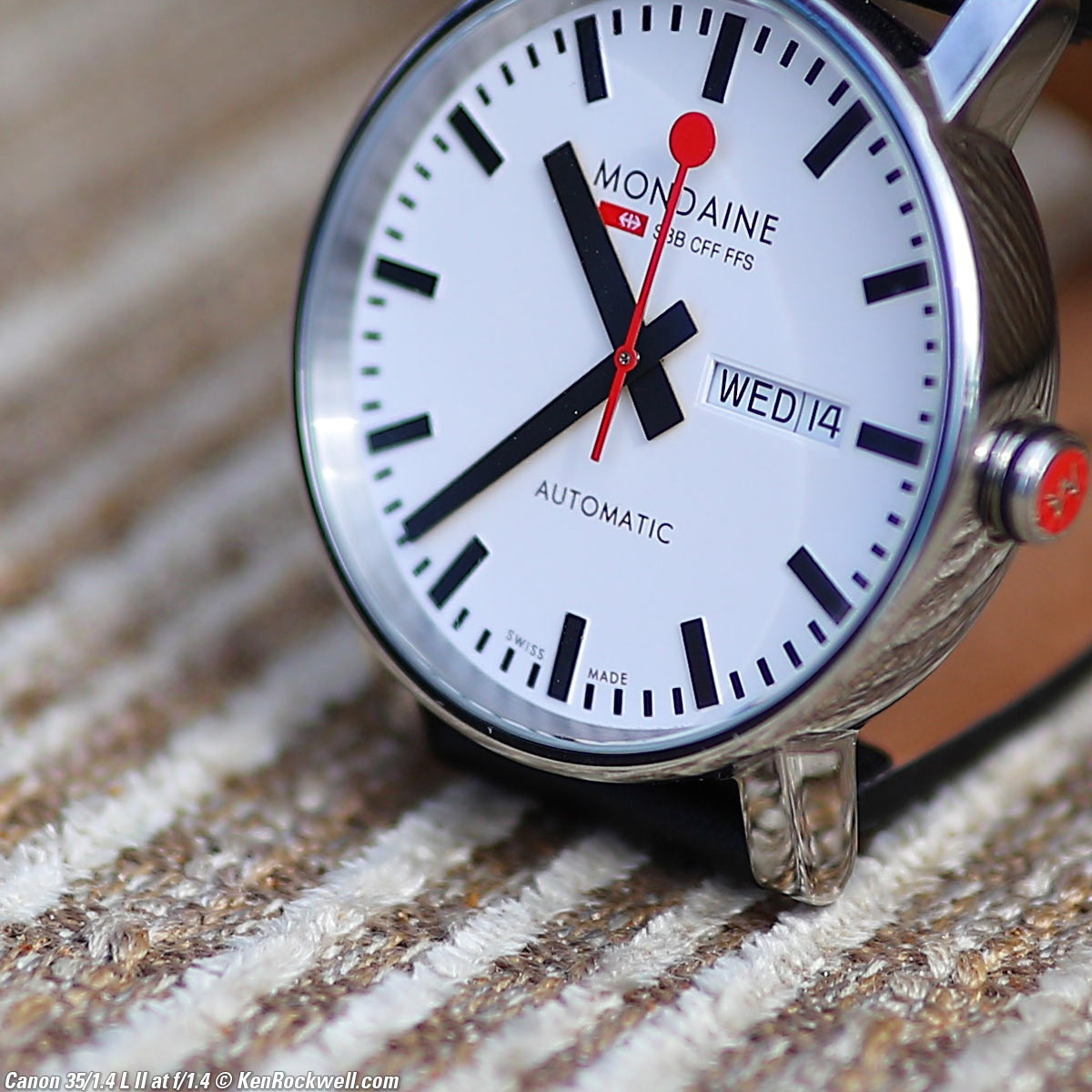Home Donate New Search Gallery Reviews How-To Books Links Workshops About Contact
Canon 35mm f/1.4 L II
EF USM (2015-today)
Sample Images Intro Specs Performance
Canon EF 35mm f/1.4 L II USM (works on all Canon DSLR and AF 35mm cameras, 72mm filters, 26.8 oz./760 g, 0.92'/0.28m close focus, about $1,799). enlarge. I got mine at Adorama; I'd just as well get it at Amazon, at Crutchfield or at B&H.
This all-content, junk-free website's biggest source of support is when you use those or any of these links to approved sources when you get anything, regardless of the country in which you live. Canon does not seal its boxes, so never buy at retail or any other source not on my personally approved list since you'll have no way of knowing if you're missing accessories, getting a defective, dropped, damaged, returned, store demo or used lens. My approved sources ship from remote automated warehouses where no salespeople or lookie-loos can ever get their greasy fingers on your new lens or drop it before you do. Buy only from the approved sources I use myself for the best prices, service, return policies and selection. Thanks for helping me help you! Ken.
Adorama pays top dollar for your used gear, especially the original Canon 35mm f/1.4 L.
October 2015 Canon Reviews Canon Lenses All Reviews
original Canon 35mm f/1.4 L (1998-2015)
Nikon 35/1.4G (2010-)
Nikon 35/1.4 AI-s (1969-)
Sample Images (more later in the review) top
Sample Images Intro Specs Performance
See also Yosemite and the Eastern Sierra, October 2015.
Crazy Lit-Up Pumpkin Decoration, Bridgeport, October 2015, 8:05 P.M. Canon 5DS R, Canon 35mm f/1.4 L II, f/1.6 at 1/30 at Auto ISO 800, Perfectly Clear. bigger.
Ring Around the Moon, October 2015, 9:01 P.M. Canon 5DS R, Canon 35mm f/1.4 L II, 15 seconds at f/2.8 at ISO 100. bigger.
Daytime, 13 October 2015. Canon 5DSR, Canon 35/1.4 L II, f/10 at 1/400 at Auto ISO 100. bigger or 50 MP camera-original © JPG to explore on your desktop computer.
Only the lamp on the left is actually in focus. You can taste each bug caught in the spider web, and easily read the labels on the light bulb holders.
Shot at f/1.6: Opus Bank, 13 October 2015. Canon 5DSR, Canon 35/1.4 L II, f/1.6 at 1/30 at Auto ISO 200. bigger or 50 MP camera-original © JPG to explore on your desktop computer.
Super-sharp at f/1.4 edge-to-edge. Also not how the high speed lets us shoot at ISO 200 for a sharper picture, not ISO 800 as we'd need with an f/2.8 lens.
Shot at f/1.4: Palm, 09 October 2015. Canon 5DSR, Canon 35/1.4 L II, f/1.4 at 1/1,000 at Auto ISO 100. bigger or 50 MP camera-original © JPG to explore on your desktop computer.
Super-sharp at f/1.4 edge-to-edge, but of course almost nothing is actually in focus at f/1.4 with a three-dimensional subject like this.
Wood and Screw, 09 October 2015. Canon 5DSR, Canon 35/1.4 L II, f/7.1 at 1/200 at Auto ISO 100. bigger or 50 MP camera-original © JPG to explore on your desktop computer.
Introduction top
Sample Images Intro Specs Performance
This Canon 35mm f/1.4 L II USM replaces the original Canon 35/1.4 L USM. It is the world's most optically perfect 35mm f/1.4 SLR lens.
This new lens is bigger, heavier, made with more plastic and more expensive than the original — but is very slightly sharper at f/1.4 in the far corners, has slightly less distortion and slightly closer focussing.
Canon uses a new organic optical "BR (Blue Refractive)" schmear, which greatly reduces spherochromatism. This has the consequence of worsening bokeh, and really does greatly reduce color fringing on out-of-focus highlights.
A 35mm f/1.4 is my favorite for low-light use. It's what I grab when I head out for hand-held night photography. A 35mm f/1.4 can be shot hand-held in the real world much more successfully than any other lens. 50mm lenses have to be shot at faster shutter speeds when hand-held, eliminating any small f/stop improvement, and more importantly, 50mm lenses have only half the depth-of-field as 35mm lenses, so when the light gets dim, you'll get twice as much in focus with the 35mm. With an f/1.2 or f/1 50mm lens, nothing is in focus, while at f/1.4 with a 35mm lens there is enough depth of field to be useful in real-world shooting.
A 24mm f/1.4 works even better in the dark, but it's too wide for general purpose use.
Everyone should have a 35mm f/1.4, one of which has been in every journalist's bag since it was invented by LEICA in 1960, and then replaced by Nikon's 35mm f/1.4 since 1969. It lets us shoot news and action deeper into the night than anything else. IS and VR can't help if the subject is in motion; only gathering more light and allowing faster shutter speeds can stop action in the dark.
Format
This is a full-frame lens, and it works on all formats.
Full frame lenses are at their best on full-frame, which is how I will be reviewing it.
You may make the usual inferences when used on smaller sensors.
Compatibility
This L lens is optimized for 35mm film and full-frame digital, and of course works on 1.3x and 1.6x Canon cameras.
This Canon EF EOS 35mm f/1.4 L II works perfectly with every Canon EOS camera ever made, meaning every Canon DSLR and every Canon autofocus film camera made since 1987.
This means of course it works great on today's 5DS & 5DS R, 5D Mark III, 6D and Canon 7D Mk II, and it works flawlessly on my original Canon EOS 650 from 1987!
With the EOS-M Adapter, it also works on Canon's EOS-M mirrorless cameras.
Canon 35mm f/1.4 L II. bigger.
Specifications top
Sample Images Intro Specs Performance
Name
Canon calls this the CANON LENS EF 35mm f/1.4 L II USM.
EF means "electronic focus," meaning that there is an autofocus motor in the lens itself. All Canon lenses since 1987 have been EF.
L only means as expensive as L; it means nothing technically.
II means a newer version.
USM means Ultra-Sonic autofocus Motor. This means autofocus is almost silent, and that you can grab the big focus ring for instant manual focus override at any time.
Optics top

Canon 35/1.4 II internal construction. Two Aspheric elements, one UD and one schmear of BR organic material between two regular glass elements.
14 elements in 11 groups.
2 pressed aspheric elements.
One UD glass element.
Rear focus.
One schmear of BR "blue-spectrum refractive" organic material, shown in violet. The molecular design of the BR material refracts blue light more than other existing materials like UD and Super UD glass and Fluorite. It's used to control axial chromatic aberration (color fringing) as effectively as possible.
If you're paying attention, the key is that the BR material isn't glass and isn't an element; it's a goo that's simply schmeared (spread) in the space between two glass elements!
SWC sub-wavelength variable-index-of-refraction coating on the rear surfaces of the first two highly curved elements.
Fluorine front and rear coatings to repel dirt and fingerprints.
Diaphragm top
Front, Canon 35/1.4 L II at f/1.4 (EF diaphragm not seen). bigger.
9 rounded blades.
Stops down to f/22.
Focal Length top
35mm.
On 1.3x Canon cameras it will see angles-of-view similar to what a 44mm lens would see on a 35mm camera.
On 1.6x Canon cameras it will see angles-of-view similar to what a 55mm lens would see on a 35mm camera.
Angle of View (on 35mm and full-frame cameras)
63º diagonal.
38º vertical.
54º horizontal.
Close Focus top
0.92 feet (0.28 m), specified, from the image plane.
Maximum Reproduction Ratio top
1:4.76 (0.21x).
Hard Infinity Focus Stop? top
No.
You have to let the AF system focus for you at infinity.
Focus Scale top
Yes.
Depth-of-Field Scale top
Yes.
Infra-Red Focus Index top
None.
Filter Thread top
72mm.
Plastic.
Does not move.
Size top
3.16" diameter x 4.15" long (80.4 x 105.5 mm).
Weight top
26.799 oz. (759.7 g) actual measured weight.
Rated 26.8 oz. (760 g).
Hood top

Canon EW-77B hood and 35mm f/1.4 L II.
EW-77B plastic bayonet petal hood, included ($70 to replace, geeze!).
As of August 2015, only fits this 35mm f/1.4 II lens.
It has a press lock on the left side as shown above.
Caps top
72mm E-72 II front, included.
Standard EOS cap rear, included.
Case top
LP1219 sack, included ($31 to replace).
Introduced top
27 August 2015, 12:01 AM NYC time.
Promised for top
October 2015.
Canon Model Number top
EF3514L2.
Canon Product Code top
9523B002 (9523B001 in Japan).
JAN Code top
4549292-010237.
Price, USA top
2015 August : $1,799. (¥285,000 in Japan.)
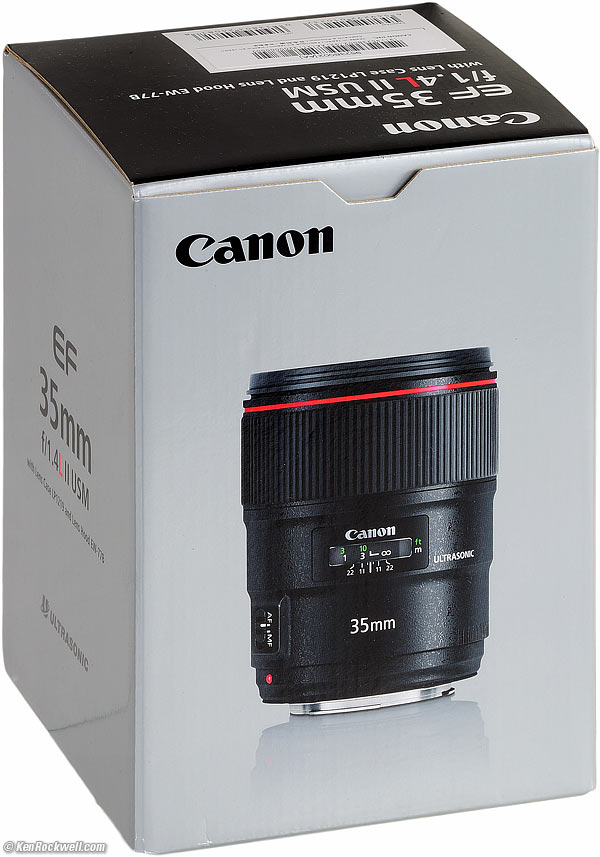
Box, Canon 35/1.4 L II.
Performance top
Sample Images Intro Specs Performance
Overall Autofocus Bokeh Color Distortion
Ergonomics Falloff Filters Focus Breathing
Flare & Ghosts Lateral Color Fringes Macro
Mechanics Sharpness Sunstars Spherochromatism
Overall performance top
This is the world's sharpest 35/1.4 SLR lens. The previous lens was also spectacular, and this new one excels for astronomers who need it sharp out to the corners on full-frame at f/1.4.
It also surprisingly has the least distortion of any similar lens.
Focus performance top
AF is fast and quiet.
You can't hear the ultrasonic motor, but the lens does make some noise as things move around inside. The original Canon 35mm f/1.4 L (1998-2015) is quieter.
AF Speed
Autofocus is as fast as all the other Canon wide lenses. No news is good news here.
Auto/Manual Switching
Just grab the focus ring anytime for instant manual-focus override.
To lock it into manual mode, move the switch on the lens to MF.
Bokeh performance top
Bokeh, the quality of out-of-focus areas as opposed to the degree of defocus, is fair.
The only way to get anything much out of focus with a wide lens like this is to get very close and shoot at f/1.4, and when you do, the backgrounds are soft, but don't just melt away into a wash of color as we'd like.
Here's a full-frame samples shot wide open from headshot distance:
Canon 35/1.4 L II at f/1.4 on full-frame. bigger or 50 MP camera-original © JPG to explore on your desktop computer.
Note how sharp is the only thing in focus, the center, in this shot at f/1.4.
Color Rendition performance top
The color balance of this 35 1.4 II seems the same as my other Canon EF lenses, no news here.
It has significantly less spherochromatism than the original Canon 35mm f/1.4 L.
Distortion performance top
The Canon 35 1.4 II has no visible distortion, although it has a little bit of barrel distortion at its closest focus distance.
For critical scientific use, these values in Photoshop's Lens Distortion tool will remove the minor distortion. These aren't facts or specifications, they are the results of my research that requires hours of photography and calculations on the resulting data.
|
On Full-frame and 35mm |
1' (0.3m) |
+1.5 |
3' (1m) |
+0.7 |
10' (3m) |
+0.5 |
30' (10m) |
+1.0 |
© 2015 KenRockwell.com. All rights reserved.
Ergonomics performance top
Canon 35/1.4 L II. bigger.
Ergonomics are perfect.
Just grab the big focus ring at any time for instant manual override. One firm fingertip will do it.
The AF - MF switch falls right under your thumb.
Falloff (darkened corners) performance top
In a DSLR with an automatic correction profile like the 5DS R, 7D Mk II, 6D, 5D Mk III and 1DX, the falloff is completely invisible.
Shot on 35mm film, or a camera without a profile (or with the correction turned off), there is strong falloff at f/1.4 on full-frame, but it goes away by f/2.
It's much less when shot on a cropped-sensor body due to the crop factor.
I've greatly exaggerated the falloff by shooting a flat gray target and presenting it against a gray background:
Canon 35mm f/1.4 L II falloff on Full-Frame Corrected on 5DS R
© 2015 KenRockwell.com. All rights reserved.
uncorrected
© 2015 KenRockwell.com. All rights reserved.
|
Filters, Use with performance top
There's no problem with vignetting even with a stack of four regular filters on full-frame.
Even a stack of five ordinary filters has no vignetting on full-frame, except when stopped down at close focus distances, For normal full-frame use, even a stack of five filters works fine.
There's no need for thin filters; regular thick and rotating filters work great.
Focus Breathing performance top
Focus breathing (the image changing size as focused) is mostly of interest to cinematographers who don't want the image changing size ("breathing") as the lens is focused among different subjects.
The image gets a little bit larger as focussed more closely.
Flare & Ghosts performance top
You really have to push it hard to see any ghosts.
Wide open under the right conditions there can be a magenta apparition opposite a brilliant point of light:
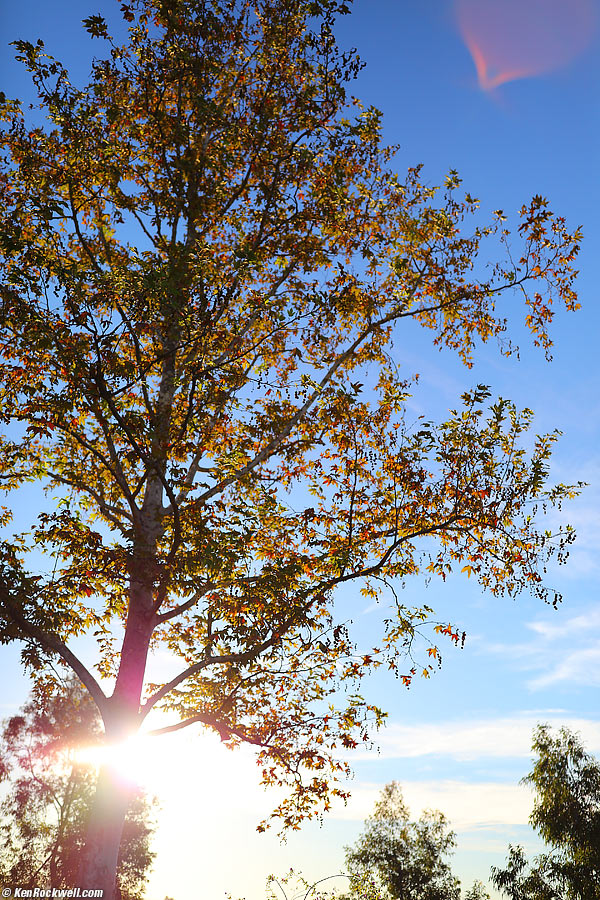
Canon 35/1.4 L II shot at f/1.4. Note ectoplasm in upper right.
You really have to push it to see anything at middle apertures:
Canon 35/1.4 L II shot at f/4. Note tiny green dot in pineapple. bigger.
At the smallest apertures there can be an orange circle outside a brilliant point of light:
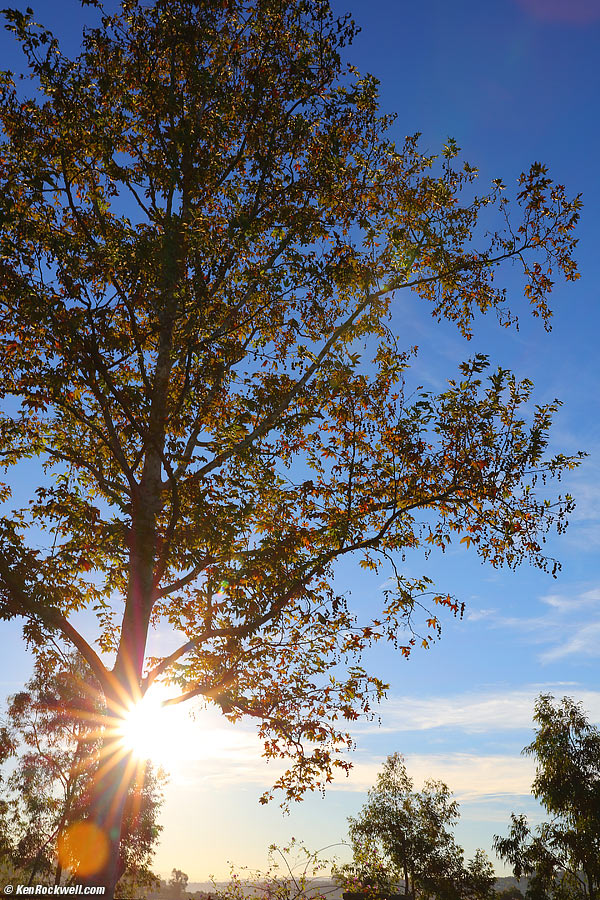
Canon 35/1.4 L II shot at f/22. Note ectoplasm in lower left and upper right.
These were the worst I could do. You'll never see any of this; 95% of my similar shots shooting this same tree had no ghosts at all.
In actual use, this is what you get: no ghosts:
Shot at f/1.6: 13 October 2015. Canon 5DSR, Canon 35/1.4 L II, f/1.6 at 1/30 at Auto ISO 640. bigger or 50 MP full-size file to explore on your desktop computer.
This lens is so sharp wide open that you can see the bugs flying around the light at the top left:
Bugs, cropped from above. If this is about 6" (15cm) on your screen, printing the complete image at this same high magnification would result in a 60 x 90" (5 x 7 feet or 1.5 x 2.3 meter) print!
Lateral Color Fringes performance top
Even at 50 megapixels, there are no lateral color fringes, even without lens a profile.
If you really squint at the results on a 5DSR and turn off the automatic compensation, there is almost a fraction of a pixel of green-magenta, but it's not really even visible, and with a lens profile, completely gone.
It's stunning how good is this lens for its lack of lateral chromatic aberration. I'm sure its designers celebrated with a lot of sake!
Macro performance top
Macro gets about as close as other modern 35/1.4s. Here's what you get on full-frame:
Mondaine A1323034811SBB at close-focus distance at f/8 on full-frame. bigger.
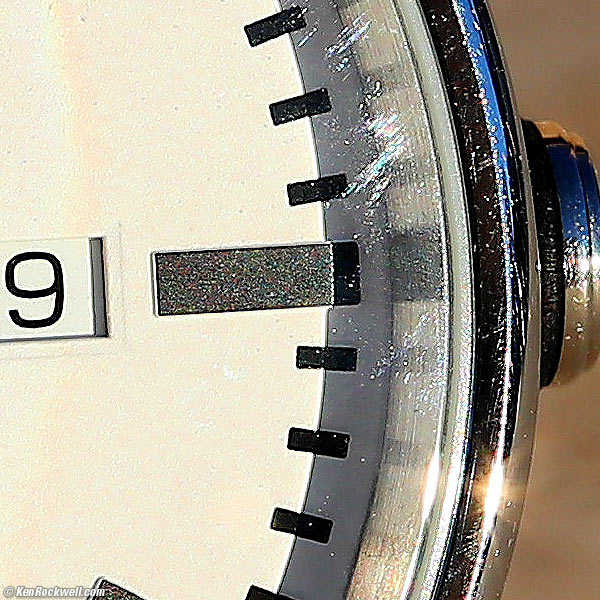
Crop from above 50 MP image at 100%. If this is about 6" (15cm) on your screen, printing the complete image at this same high magnification would result in a 60 x 90" (5 x 7 feet or 1.5 x 2.3 meter) print!
This is super-sharp at f/8, and it's also sharp at f/2:
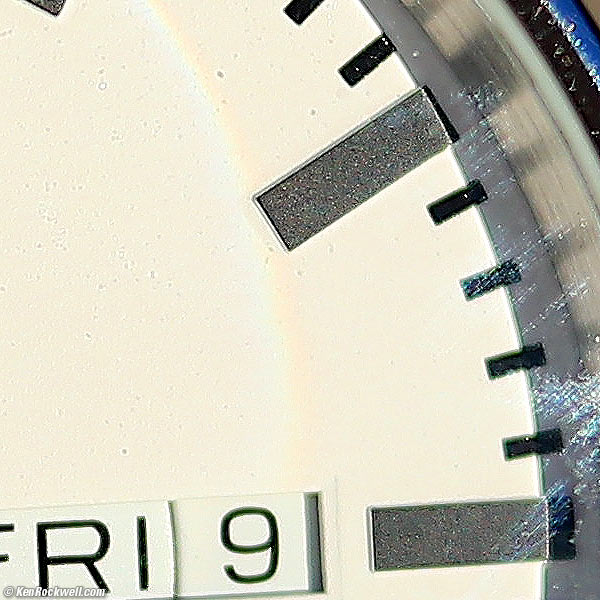
Crop from similar 50MP image at 100%. If this is about 6" (15cm) on your screen, printing the complete image at this same high magnification would result in a 60 x 90" (5 x 7 feet or 1.5 x 2.3 meter) print!
The biggest reason this f/2 shot doesn't seem as sharp as the f/8 shot is because the depth of field at this distance and this high resolution is only a few molecules. The green fringes are caused by spherochromatism on parts that aren't in perfect focus.
Mechanics performance top
Canon 35/1.4 L II. bigger.
This new Canon 35 1.4 II isn't as nicely made as the original Canon 35mm f/1.4 L (1998-2015). This new lens is mostly plastic.
Filter Threads
Plastic.
Hood Mount
Plastic.
Identity
Painted on the plastic ring between the glass and the filter ring.
Front Barrel
Plastic.
Focus Ring
Plastic, rubber covered.
Internals
Metal and plastic.
Rear Barrel (section with switch and focus distance window)
Plastic.
AF-MF Switch
Plastic.
Dust seal at mount
Yes.
Mount
Chromed metal.
Markings
Paint.
Serial Number
Laser engraved into plastic lens barrel to the right of the painted marking on the bottom.
It's nearly invisible black-on-black best seen in reflection.
Date Code
None found.
Noises When Shaken
Mild clunking.
Made in
Japan.
Sharpness performance top
Image sharpness depends more on you than your lens, and lens sharpness doesn't mean much to good photographers.
Caution aside, this is the sharpest 35/1.4 SLR lens in history. It's sharp right out to the corners at f/1.4, on a 50 MP 5DSR!
Concrete at f/1.4, 09 October 2015. Canon 5DSR, Canon 35/1.4 L II, f/1.4 at 1/4,000 at Auto ISO 100. bigger or 50 MP camera-original © JPG to explore on your desktop computer. (The darkness at the top left is a shadow.)
The original Canon 35mm f/1.4 L is among the sharpest wide lenses I've ever tested as well. This new lens is a bit sharper in the last few millimeters of the corners at f/1.4, which is the only part of the performance envelope where the original had any room for improvement.
What I see is confirmed in the MTF charts: this new lens is a bit sharper in the very farthest few millimeters on full-frame at f/1.4. Stopped down or in the center, they are the same, as is the case with most 35mm lenses.
Here are Canon's claimed MTF curves: 
Canon's 35/1.4 L II MTF Curve. (original 35/1.4 L MTF and Nikon 35/1.4G MTF)
The biggest detriment to sharpness will be a lack of proper vision and technique, never this lens. I got mine directly from Adorama. I can't vouch for anything if you get yours from a local store or chain where you never really know who's opened and played with or dropped your lens before you buy it. I never buy retail; too many risks, so why pay more? Use my personally approved sources of supply for the best results.
Sunstars performance top
Thank goodness the rounded diaphragm blades tend to straighten out from about f/8, so this lens has pretty good sunstars:
Canon 35/1.4 L II shot at f/4. bigger.
Canon 35/1.4 L II shot at f/5.6. bigger.
Canon 35/1.4 L II shot at f/8. bigger.
Canon 35/1.4 L II shot at f/11. bigger.
Canon 35/1.4 L II shot at f/16. bigger.
Canon 35/1.4 L II shot at f/22. bigger.
Spherochromatism performance top
Much to my pleasure, there is nearly no spherochromatism. Out-of-focus highlights have nearly no color fringes.
Spherochromatism, misnamed "color bokeh" by laymen, is when out-of-focus highlights take on color fringes: green in the background, and magenta in the foreground.
Spherochromatism is a completely different aberration from lateral color fringes.
See samples next under Compared.
Compared top
Sample Images Intro Specs Performance
Versus the original Canon 35/1.4 L
Canon 35/1.4 L and Canon 35/1.4 L II. bigger.
This new lens has significantly less spherochromatism than the original Canon 35mm f/1.4 L, which leads to the poorer bokeh of this new lens. This new lens is more LEICA-like, meaning insane sharpness, but at the expense of only fair bokeh. The original 35/1.4 has much better bokeh, but isn't quite as sharp at f/1.4 for three-dimensional subjects because of their spherochromatism.
Here's the spherochromatism:
Crop at 100% from 50MP image with Canon 35/1.4 L at f/1.4. bigger or camera-original 50MP file.
Crop at 100% from 50MP image with Canon 35/1.4 L II at f/1.4. bigger or camera-original 50MP file.
See how the background is tinged with green and the foreground is tinged with magenta? That's spherochromatism, which is greatly reduced in this new lens.
Both are ultra sharp. The only slight difference is in the unlikely event you have something in perfect focus in the farthest corner of full-frame at f/1.4, in which case the new lens is sharper in the last couple of millimeters than the original.
This new lens is bigger, heavier and more expensive than the original 35/1.4.
This new lens is also much more plasticy than the original. The metal filter threads, metal hood mount, metal front barrel, metal identity ring and metal focus ring of the original are now all plastic in this new lens.
This new 35/1.4 II has noisier autofocus than the original.
This new 35/1.4 II has less distortion than the original, which didn't have much to begin with.
This new lens focuses a little closer.
Versus the World
| Anni | 2015- |
1998-2015 |
2012- |
1990- |
2012- |
2010- |
| Filter Threads | 72mm |
72mm |
67mm |
52mm |
82mm |
67mm |
| Filter Threads | plastic |
Metal |
plastic |
plastic |
plastic |
plastic |
| Barrel | Plastic |
Metal and plastic |
Plastic |
Plastic |
Plastic and metal |
plastic |
| Build Feel | Good Consumer |
Pro |
Good Consumer |
Good Consumer |
Tough Consumer |
Good Consumer |
| Autofocus motor | USM |
USM |
USM |
Arc-Form Drive |
USM |
SWM |
| Instant Manual Override? | Yes |
Yes |
Yes |
No |
Yes |
Yes |
| Close Focus | 0.92' 0.28m |
1' 0.3m |
0.8' 0.24m |
0.8' 0.25m |
1.25' 0.38m |
1' |
| Maximum Repro Ratio | 1:4.76 |
1:5.5 |
1:4.3 |
1:4.76 |
1:5 |
|
| Sharpness | Excellent |
Excellent |
Excellent |
Excellent |
Excellent |
Excellent |
| Diaphragm | 9 blades |
8 blades |
8 blades |
5 blades |
9 blades |
9 blades |
| Sphero-chromatism | minor |
strong |
||||
| Sunstars | 18 points |
8 points |
8 points |
10 points |
18 points |
soft 18 pts. |
| f/minimum | f/22 |
f/22 |
f/22 |
f/22 |
f/16 |
|
| Distortion @ 3m | +0.5 |
+1 |
+1.2 |
+1.1 |
+1.5 |
|
| Bokeh | ||||||
| Length | 105.5mm |
86mm |
63mm |
42mm |
123mm |
90mm |
| Diameter | 80.4mm |
79mm |
78mm |
67mm |
83mm |
83mm |
| Weight | 26.8 oz. 760g |
20.5 oz. 582 g |
11.9 oz. 336 g |
7.4 oz. |
28.4 oz. |
21.2 oz. |
| Price, 12/2012 | n/a |
|||||
| Price, 4/2013 | n/a |
|||||
| Price, 4/2015 | n/a |
$250 used |
||||
| Price, 8/2015 | $200 used |
|||||
| Price, 10/2015 | $175 used |
|||||
| Price, 11/2015 | $200 used |
|||||
| Price, 03/2016 | $200 used |
Versus Junk Brands
Brands like Sigma aren't competition; those are consumer lenses.
Optics may or may not be OK, but more important is that the junk brands won't last much past 7 years, or even be repairable when you might need it after all those years when those brands try to walk away from supporting their old products.
When a pro buys a lens, he needs it to be earning money for him for a couple of decades at least. Pros don't buy lenses as if they were disposable consumer electronics like VCRs or HDTVs; we need them to be in our bag making us money for decades so we don't have to worry about them.
Typically off-brand lenses won't work on cameras 10 years from now; they can't predict what will be needed to work with the camera you'll buy in 2025, while Canon ensures all its new cameras work with all EF lenses ever made. My 35/1.4 works great with all my Canons made since 1987, and my 1987 Canon EF lenses like my fisheye work flawlessly with my new 5DS R. I can't afford junk brands that may or may not work with my cameras in the future; I've been shooting SLRs for over 45 years so I've learned a bit as the decades keep coming. Pros can't afford to rebuy everything every few years.
If you can't afford this new 35/1.4 lens, get the original 35/1.4 L, or buy an EF 35mm f/2 used for $175 and you're fine — just don't expect junk brands to work well for long periods of time on your camera.
Recommendations top
Sample Images Intro Specs Performance
As I've foretold for many years, this new lens is bigger, heavier and made of a lot more plastic than the original Canon 35/1.4 L — and costs much more. Both have spectacular optics. At f/1.4, this new lens' lack of chromatic aberrations for slightly-out-of-focus subject matter (spherochromatism) gives it the edge over the original — but not for bokeh.
Get this new lens if you're an astronomer or other person who demands the very sharpest results in the last few millimeters of the full-frame corners at f/1.4. The original is no slouch, and this new lens is significantly better — but only at f/1.4 in the far corners.
This new lens has less distortion and much less spherochromatism than the original, however this lack of spherochromatism gives it somewhat worse bokeh than than the original.
If you're using this for photojournalism, the smaller size and quieter focus of the original lens will mean more than any microscopic potential improvement in optics, especially considering that in real-world shooting almost nothing is ever in perfect focus due to limited depth of field.
Get this new lens if you need the ultimate in sharpness and freedom from color fringes, and get the original if you prefer smaller size, lighter weight, higher mechanical qualty and the original's smoother, more organic bokeh.
I'd use a 72mm B+W 010 MRC UV filter for protection, or the Canon 72mm UV, or an 72mm Hoya MC UV. You don't need a "slim" filter; any normal 72mm filter works great. These filters are all very good; the reason to pay $50 for the B+W or Canon filter is simply if you feel better with a $50 rather than a $17 filter on an $1,800 lens.
DO NOT get your lens from anyplace, especially your local retail store, unless it's on my list of approved sources, because Canon doesn't seal its boxes in any way. If you risk buying at retail or from another online source, you'll have no way of knowing how many people have already played with your "new" lens, or if it's used, returned, incomplete or damaged. I use the sources I do because they ship from secure remote warehouses where no customers or salesmen can get their sticky hands on your new lens before you do. Approved sources have the best prices, service, return policies and selection, which is why I've been buying from most of them since the 1970s.
This all-content, junk-free website's biggest source of support is when you get yours via these approved links to it at Adorama, at Amazon, at Crutchfield or at B&H. When you use those or any of these links to approved sources when you get anything, regardless of the country in which you live, it helps me keep adding to this free website — but I receive nothing for my efforts if you risk buying elsewhere.
Thanks for helping me help you!
Ken.
More Information top
Sample Images Intro Specs Performance
© Ken Rockwell. All rights reserved. Tous droits réservés.
Help me help you top
I support my growing family through this website, as crazy as it might seem.
The biggest help is when you use any of these links when you get anything, regardless of the country in which you live. It costs you nothing, and is this site's, and thus my family's, biggest source of support. These places have the best prices and service, which is why I've used them since before this website existed. I recommend them all personally.
If you find this page as helpful as a book you might have had to buy or a workshop you may have had to take, feel free to help me continue helping everyone.
If you've gotten your gear through one of my links or helped otherwise, you're family. It's great people like you who allow me to keep adding to this site full-time. Thanks!
If you haven't helped yet, please do, and consider helping me with a gift of $5.00.
As this page is copyrighted and formally registered, it is unlawful to make copies, especially in the form of printouts for personal use. If you wish to make a printout for personal use, you are granted one-time permission only if you PayPal me $5.00 per printout or part thereof. Thank you!
Thanks for reading!
Mr. & Mrs. Ken Rockwell, Ryan and Katie.
Home Donate New Search Gallery Reviews How-To Books Links Workshops About Contact

